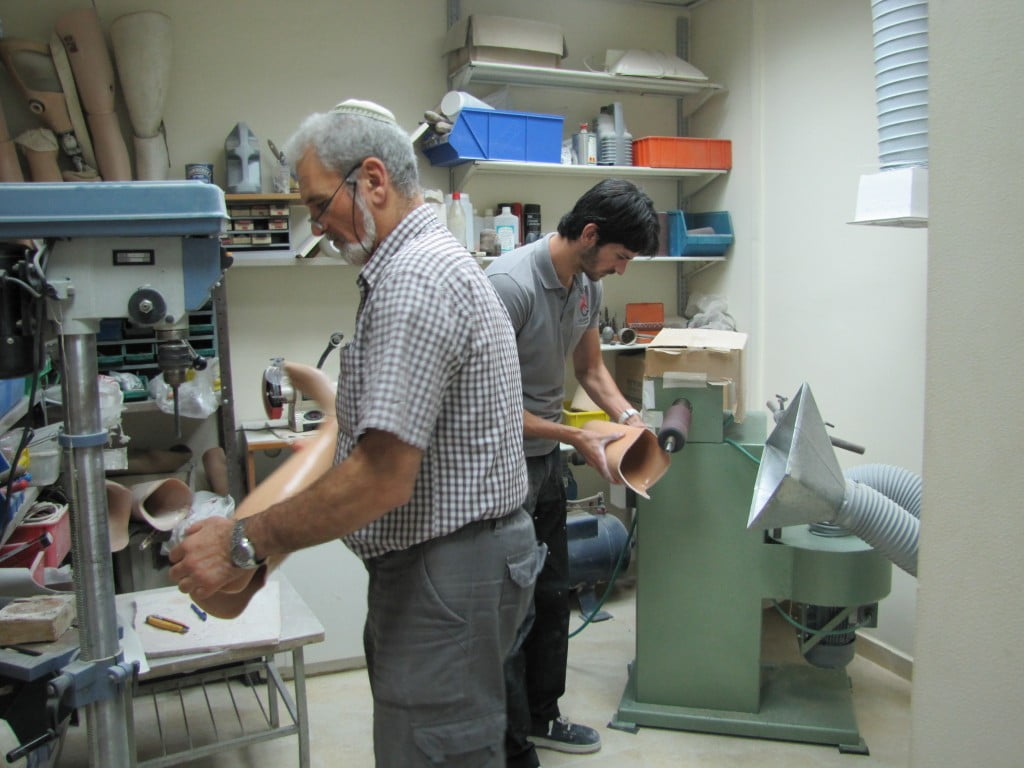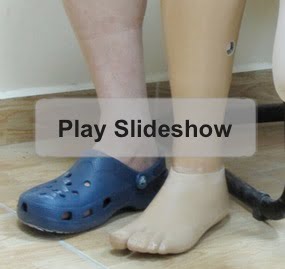Few could imagine what is going on inside the small warehouse overlooking Israel’s Ben Gurion Airport. Scattered throughout the space, hundreds of limbs are piled onto each other: arms, legs; some painted the color of human flesh, others colored deep hues of blue or red.
This is Y.D Gapim and it is here that patients come from all over the world to be fitted with prosthetic limbs. The man behind the initiative is Yehuda Pilosof, a charismatic, deeply spiritual orthopedic technician trained both in Israel and abroad, whose life motto is to “make possible what is impossible.”
Pilosof, together with his son Israel, a former soccer player, works around the clock sculpting, measuring, coloring and matching prosthetic limbs to the patients who lost theirs. The father-son team often travel long distances to help patients or train other orthopedic technicians around the world.
“Helping the disabled is not always an easy or simple task,” says Pilosof. “It can be difficult spiritually, mentally and physically as well. However, the most difficult cases are those which motivate me most.”
After Haiti’s catastrophic earthquake in January 2010, Pilosof found himself among the first Israeli medical practitioners sent to give immediate medical treatment to the victims. There he slept amidst the rubble and ruins and dealt with some of the most horrifying injuries of his 40-year-long carreer.
Coming back to Israel, Pilsof says he never imagined he would encounter one of his most memorable Haitian patients months later.
Pilosof first met George at the beginning of this year in Tel Hashomer hospital. George, who had lost his right leg during the earthquake and severely injured his left leg and arm, was flown over by the hospital to Israel for medical treatment.
What Pilosof did not know was that George had been a professional dancer in Port-au-Prince as well as the head of a dance company he founded. To George, his injuries signified more than just the loss of his limbs; they were the loss of his identity.
Sign up for our free weekly newsletter
Subscribe“I remember the first time George tried on the new prosthetic we made,” says Pilosof. “We expected him to take his first baby steps without a walker, his first steps since he lost his leg. Suddenly George stood up and started dancing. My son and I were in utter shock. We had no idea he was a dancer and what a dancer! We wish we could dance half as well with our own legs,” he added.
Incredibly, George has since returned to Haiti and continues to dance and lead his performance arts company.
Watch George’s story in the video below:
[youtube]http://www.youtube.com/watch?v=3CghS9SHUsI&feature=player_embedded[/youtube]
Recently, Pilosof and his son returned from Peru where they trained local orthopedics and doctors as part of a prosthetics seminar. “The tools that were used in the local hospital to fit patients with prosthetics were the same methods we used in Israel thirty years ago” says Pilosof. “The local hospital and technicians were lacking the resources and training that can offer patients a higher standard of living.
“Here too, a male and female patient just fitted with new prosthetics stood up and began dancing with each other, out of joy. I was extremely moved and everyone in that room was intears.”
The orthopedic technician believes “there needs to be a strong will on both the side of the patient and the practitioner for the therapy to work. The healing process does not end with the construction of the prosthetic.” Pilosof says his practice, which is widely recognized in Israel, includes just as much emotional healing as physical healing. The process with his patients therefore includes a great deal of verbal communication, which he believes is crucial to overcome the trauma of losing a limb and starting life with a new one.
Pilosof’s dream is to continue his work and open a training center in Israel that would offer seminars for orthopedic technicians and doctors from all over the world. Pilosof wants to open a school that combines his practice with alternative medicine and spiritual healing.
Photos by Michal Divon
Related posts

Israeli Medical Technologies That Could Change The World

Harnessing Our Own Bodies For Side Effect-Free Weight Loss

Missing Protein Could Unlock Treatment For Aggressive Lung Cancer





Facebook comments